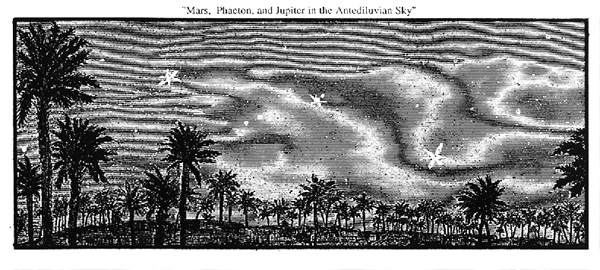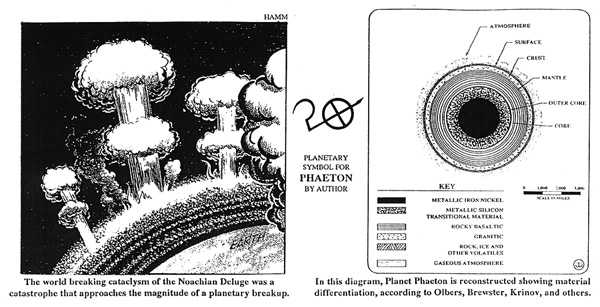
PHAETON: THE LOST PLANET1
An Ancient World that Perished
J. Timothy Unruh
Imagine yourself taking a journey back in time, if it were possible, to a day perhaps 5,000 years ago. When we arrive at that early epoch we find a vastly different Earth. The geography and climate is noticeably different. Numerous exotic plant and animal species are present. There are dinosaurs roaming about. People live in scantily insulated yet well built dwelling structures which provide safety and refuge from the traffic lanes of extraordinarily large wild beasts. At nightfall, when the stars appear, there are several noticeably bright stars which continually change their positions from night to night, the planets. Everything in the solar system seems to appear as we know it in the twentieth century, with one major exception. There is an additional planet in the sky, with a brightness comparable to that of Mars and Jupiter. Then one night it suddenly and unexpectedly explodes, like a nova in our solar system. It expands and brightens to a daylight brightness and then fades. In a few months, the leading edge of the blast reaches Earth. The day and night sky is set ablaze with great showers of brilliant meteors. Such a spectacle would undoubtedly leave a most ominous and profound impression on the inhabitants of the time.
As we return to our present century we realize that the mystery and demise of the lost planet was all but forgotten in the annuals of history, until our story continues in the year 1772 when man begins to rediscover the evidence of the bygone event. At that time the astronomer Johann Titius recognized a curious fact about the spacing of the planets in the solar system: each of the, then six known, planets is roughly twice the distance of the previous one from the Sun, with one conspicuous exception, the gap between Mars and Jupiter. The big question of the day raised by Titius was: “Are we to assume that the Divine Creator has left this reservation empty?” It was obvious that something was “not quite right.” Not long after, astronomer Johann Bode published this curious fact about the spacing of the planets in 1778 as a “law,” now known as Bode's law. When planet Uranus was discovered by William Herschel it was found to be in excellent agreement with Bode's law. This circumstance brought great attention to the predicted missing intraMartial- Jovian planet. Astronomical “search parties” were organized to find the missing planet, but to no avail. Then on the very first day of the next century Giuseppe Piazzi, the director of an observatory on the island of Sicily, happened upon an unidentified star while making routine telescopic “patrols” of the sky. After watching the new star change position over a period of several evenings he reported it to other astronomers, including Bode. Interesting enough, Piazzi was not among the organized team of stellar “police” actually searching for the missing planet.
After the Roman goddess of agriculture, it was given the name Ceres. The new planet, just like Uranus, was found to be exactly where it should be in its distance form the Sun. This planet, although, was so incredibly tiny compared to the other planets that it was not even large enough to constitute a modest sized moon. Shortly after, another tiny planet was discovered by Wilhelm Olbers. Then even more of these Lillyputian wonders were found. On account of these discoveries Olbers conjectured that these new little “worlds” were mere fragments of a single large planet which had been burst asunder by some great convulsion, thereby producing the remnants that were now being discovered telescopically. By his most profound theory Olbers correctly predicted that many more of these pieces would be found.
Olbers' planetary disruption theory was the first and most viable hypothesis of what happened, but the better known and more prestigious astronomer, Marquis de Laplace whose nebular theory of the origin of the solar system was in vogue at the time, attacked the ideas of Olbers. Thus the planetary disruption theory has since been cast into disfavor by most scientists ever since. Hence it is now held that the more than 6,000 pieces of debris logged so far, and now called asteroids, are the remains of a planet which never quite formed between Mars and Jupiter, due to the gravitational influence of “nearby” Jupiter. In spite of its rejection by the majority of scientists, the disruption theory remains the most workable hypothesis, a hypothesis supported by evidence more startling than ever, especially since the advent of the space age. Not only are the asteroids irregular shaped fragmental bodies, most of them occur in a stream just where a planet should be. Their material constitution is indicative of having been integrally formed within the original mass of a planet sized body. As well, the pieces exhibit “explosion signatures” in their distribution and orbital interrelationships. Furthermore, the presence of comets, meteorites, and zodiacal dust is also indicative of an origin in a catastrophe of planetary proportions. In a nebular context involving great ages none of these should still be present, as they would have already been “cleaned up” long ago. Many more evidences have been identified and described. Unlike their American counterparts, Russian scientists on the whole are much more inclined toward the disruption theory as the cause of the asteroids, comets, and meteoroids. One Russian astrophysicist has even constructed a model of the original planet and given it the name Phaeton, after the mythological Phaethon who tried to drive his father's chariot across the heavens, but being unable to control his fiery steeds, he perished.
Just how the planet itself was demolished remains a mystery although it seems probable that some kind of internal instability was responsible; or perhaps it was destroyed by outside forces, or even from the intervention of intelligent beings. The latter would make sense as a consequence of a “war in heaven” (Ezekiel 28; Isaiah 14; Revelation 12) amongst the ranks of the angelic hosts. War is essentially the result of a spiritual problem, and spiritual problems usually have physical consequences. We know this all to well in this “present evil world.” In consideration of the fact that our efficacious God, in the beginning, created everything whole, complete and perfect, the nebular theory could not be held up as a viable hypothesis. The disruption theory, although, is much more in keeping with the Biblical idea that the entrance of iniquity into God's once perfect creation has tainted the physical universe with its destructive manifestations - exploded stars and broken planets. God's perfect creation certainly would not include the byproducts of discord, such as the fragmentary bodies of the asteroids. The surmise and demise of Phaeton is indeed an extraordinary account which certainly provides a fascinating chapter in the mysteries of astronomy.

(This article is an excerpt from the author's book Phaeton the Lost Planet, 1995)